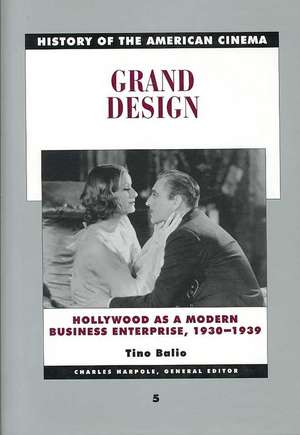History of the American Cinema: Hollywood as a Modern Business Enterprise, 1930-1939: History of the American Cinema (Hardcover), cartea 05
Autor Tino Balio, Donald Craftonen Limba Engleză Hardback – 31 ian 1993
Preț: 1170.76 lei
Preț vechi: 1427.76 lei
-18% Nou
Puncte Express: 1756
Preț estimativ în valută:
224.04€ • 234.20$ • 189.32£
224.04€ • 234.20$ • 189.32£
Carte indisponibilă temporar
Doresc să fiu notificat când acest titlu va fi disponibil:
Se trimite...
Preluare comenzi: 021 569.72.76
Specificații
ISBN-13: 9780684191157
ISBN-10: 0684191156
Pagini: 496
Dimensiuni: 188 x 267 x 36 mm
Greutate: 1.28 kg
Editura: Charles Scribner's Sons
Seria History of the American Cinema (Hardcover)
ISBN-10: 0684191156
Pagini: 496
Dimensiuni: 188 x 267 x 36 mm
Greutate: 1.28 kg
Editura: Charles Scribner's Sons
Seria History of the American Cinema (Hardcover)
Textul de pe ultima copertă
Celebrated as "Hollywood's greatest year", 1939 has often been considered the apex of the studio system and the movies it produced, including Gone with the Wind, The Wizard of Oz, Stagecoach, Mr. Smith Goes to Washington, and so many other memorable pictures. It was a time when the studios exercised nearly absolute control over their product and won government sanction for the informal oligopoly that had sprung up in previous decades. In short, the film industry became a modern business enterprise - rationalized from planning through assembly-line manufacture to exhibition in studio-owned theater chains. Even community reception and the public personas of such great stars as Bette Davis, Clark Gable, and Humphrey Bogart were subject to studio influence. In this fifth volume of the award-winning History of the American Cinema, Tino Balio examines every aspect of the filmmaking and film exhibition system as it matured during the Depression era. He discusses the Hollywood studios (major, minor, and "poverty row") in relation to their all-powerful (and little understood) front offices in New York; the prevailing exhibition and advertising practices; the star system; and the key trends that dominated Hollywood production: prestige pictures, musicals, women's films, comedies, social problem films, and horror pictures. A number of distinguished guest contributors fill out the picture with analyses of censorship and the emergence of the Production Code (Richard Maltby), technology and the "classical" Hollywood style (David Bordwell and Kristin Thompson), the B Film (Brian Taves), documentary (Charles Wolfe), and the avant-garde (Jan-Christopher Horak).







